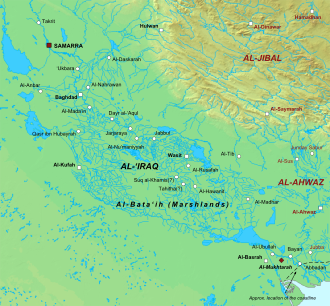Hamdan Qarmat
Hamdan Qarmat ibn al-Ash'ath | |
|---|---|
حمدان قرمط بن الأشعث | |
| Personal life | |
| Born | Furat Badaqla |
| Died | 899 or later |
| Religious life | |
| Religion | Isma'ilism |
| Sect | Qarmatians |
Hamdan Qarmat ibn al-Ash'ath (
Life
Hamdan's early life is unknown, except that he came from the village of al-Dur in the district of Furat Badaqla, east of
His surname "Qarmat" is considered as being probably of
Missionary activity

The dā'ī al-Husayn al-Ahwazi had been sent by the Ismai'li leadership at
His most prominent disciple and aide was his brother-in-law
Hamdan's agents collected taxes from the converts, including a one-fifth tax on all income (the khums), to be reserved for the mahdī.[1][4] Although Hamdan corresponded with the Salamiya group, their identity remained a secret, and Hamdan was able to pursue his own policy locally. Thus in 880 his numbers were large enough to make overtures for an alliance with the leader of the Zanj, Ali ibn Muhammad, who rebuffed the offer.[4] In 890/91, a fortified refuge (dār al-hijra) was established by Hamdan for his supporters near Kufa.[7]
For several years following the suppression of the Zanj Revolt in 883, Abbasid authority was not firmly re-established in the sawād. Only in 891/92 did reports from Kufa denouncing this "new religion" and reporting on mounting Qarmatian activity begin to cause concern in Baghdad. However, no action was taken against them at the time. As this group was the first to come to the attention of the Abbasid authorities, the label of "Qarmatians" soon came to be applied by Sunni sources to Ismai'li populations in general, including those were not proselytized by Hamdan.[1][8]
Doctrine
No direct information on the doctrine preached by Hamdan and Abu Muhammad is known, but modern scholars like
Split with Salamiya and possible reconciliation
| Part of Isma'ilism |
|---|
 |
|
|
In 899, following the death of the previous leader of the sect at Salamiya,
Abu Ali Hasan claimed descent from
Subsequent history of the Qarmatian movement
After Hamdan's disappearance, the term "Qarmatians" was retained by all Isma'ilis who refused to recognize the claims of Sa'id, and subsequently of the Fatimid dynasty.[5] At times it was also applied by non-Isma'ilis in a pejorative sense to the supporters of the Fatimids as well.[5] Abu Muhammad was murdered in the same year at the instigation of Zakarawayh ibn Mihrawayh, apparently on the instructions of Salamiya.[11][14] Hamdan's and Abu Muhammad's followers threatened to kill Zakarawayh, who himself was forced to hide.[14] The dā'īs appointed by Abu Muhammad then resumed their work, denouncing the claims of Sa'id in Salamiya, and continuing the Qarmatian movement, although Abu Muhammad was often cited as the source of their religious and philosophical works.[15] A Qarmatian movement (the so-called Baqliyya) survived in lower Iraq for several decades thereafter, with their teachings ascribed largely to Abu Muhammad.[12]
In the
Footnotes
References
- ^ a b c d e f g h i j Madelung & Halm 2016.
- ^ a b Daftary 2007, p. 107.
- ^ Daftary 2007, pp. 107–108.
- ^ a b c d e f g Daftary 2007, p. 108.
- ^ a b c Madelung 1978, p. 660.
- ^ a b c d e f Madelung 2003.
- ^ Daftary 2007, pp. 108–109.
- ^ Daftary 2007, pp. 108, 109.
- ^ Daftary 2007, p. 109.
- ^ Daftary 2007, pp. 116–117.
- ^ a b Madelung 1996, p. 24.
- ^ a b c Daftary 2007, p. 120.
- ^ Bayhom-Daou 2010.
- ^ a b Daftary 2007, p. 117.
- ^ Madelung 2007.
- ^ Daftary 2007, pp. 122–123.
- ^ Madelung 1978, pp. 660–661.
- ^ Madelung 1978, pp. 661, 662.
- ^ Madelung 1978, p. 661.
Sources
- Bayhom-Daou, Tamima (2010). "Bāb (in Shīʿism)". In Fleet, Kate; ISSN 1873-9830.
- ISBN 978-0-521-61636-2.
- OCLC 758278456.
- ISBN 978-0-521-00310-0.
- ISBN 978-0-933273-70-2.
- ISSN 1873-9830.
- ISSN 1873-9830.
